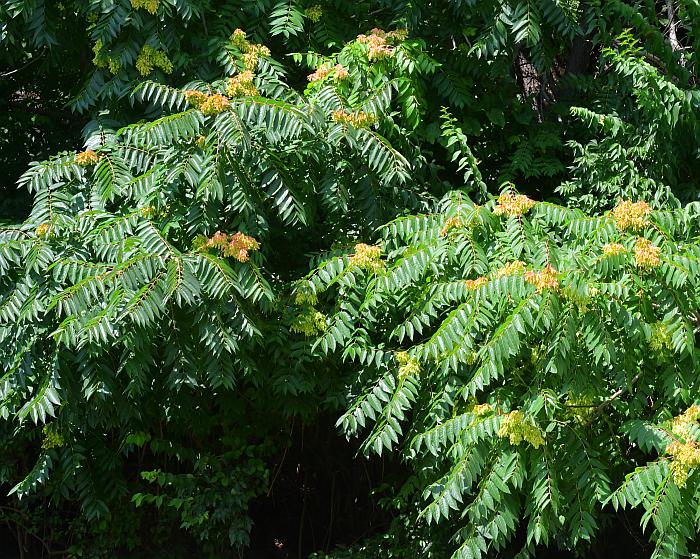Ailanthus altissimus (Mill.) Swingle
Tree-Of-Heaven

Introduced
CC = *
CW = 5
MOC = 20
© SRTurner
Ailanthus altissimus (Mill.) SwingleTree-Of-Heaven | |
 |
Introduced CC = * CW = 5 MOC = 20 |
© SRTurner |
|
Family - Simaroubaceae Habit - Small to medium sized tree, to 20 m, incompletely dioecious, colonial from root suckers. Stems - Trunks 1 or few, stout, the bark light grayish brown, initially relatively smooth, eventually developing thin, pale grooves and thin, darker ridges. Twigs stout, tan to reddish brown with numerous, slender, pale lenticels and large, prominent, more or less kidney-shaped leaf scars, the winter buds axillary (sometimes appearing asymmetrically terminal), depressed-globose, with several broadly rounded scales, densely short-hairy. Leaves - Leaves 40-100 cm long, relatively short-petiolate. Leaf blades pinnately compound with 11-41 leaflets, these opposite, lanceolate, the lateral ones often somewhat curved toward the leaf tip, rounded to shallowly cordate and usually somewhat asymmetrical at the base, sharply pointed, the margins entire or with 1-3 pairs of blunt teeth toward the base, the surfaces short-hairy and also with scattered, minute glands, sometimes becoming nearly glabrous with age, the upper surface dark green, the undersurface pale or lighter green. One or more small, rounded projections often present on leaflet surface near base. Crushed leaves emit an unpleasant stench.
Inflorescence - Terminal, large, diffusely branched panicles, lacking bracts, the numerous, individually stalked flowers solitary or in small clusters, each cluster subtended by a pair of minute, linear, reddish bracts that are shed before the flowers open.
Flowers - Mostly imperfect, but pistillate flowers sometimes appearing perfect due to presence of staminodes. Sepals 5, sometimes fused at base, triangular, spreading. Petals 5, to 4 mm long, alternating with sepals, somewhat concave, greenish, densely tomentose. Staminate flowers - Fetid. Stamens 10, erect to spreading. Filaments densely pubescent (at least in the basal 1/2), white, 2.5 mm long. Anthers yellow, 1.2 mm long. Pistillate flowers usually with 3-5 staminodes. Nectar disc present, irregularly lobed, dark purple to purplish brown. Ovary of 2-5 carpels, 2-5-locular. Style 1 per flower, with twisted, longitudinal lines equal to the carpel number, the stigma capitate and deeply 2-5-lobed.
Fruits - Schizocarps, appearing as small clusters of 2-5 samaras, these sessile, 3.0-5.5 cm long, 7-13 mm wide, narrowly oblong-elliptic, often somewhat spirally twisted toward the tip, usually strongly dark reddish-tinged at maturity, but becoming tan before dispersal. Seed 1 per samara, positioned near its midpoint, 5-8 mm long, ovate, strongly flattened, the seed coat fused to the samara wall.
Flowering - May - June. Habitat - Waste ground, along streams, base of bluffs, thickets, roadsides, railroads, commonly cultivated. Origin - Native to Asia. Lookalikes - Sumacs, especially Rhus glabra (smooth sumac). Other info. - This common tree has been collected from scattered locations in Missouri but is probably far more common than collections indicate. It has been widely cultivated and is especially prevalent around urban areas. It grows rapidly and is resistant to disease and tolerant of air pollution. Although it mainly colonizes disturbed areas, in Missouri it has been known to badly invade forest margins. Once established it is difficult to control, and it should never be deliberately spread in the wild. The common name is extremely inappropriate, at least in Missouri. Photographs taken at the Kansas City Zoo, 5-18-00 (DETenaglia); also along the Katy Trail in St. Charles County, 3-5-2012, and near Pacific, St. Louis County, MO, 7-23-2020 (SRTurner). |